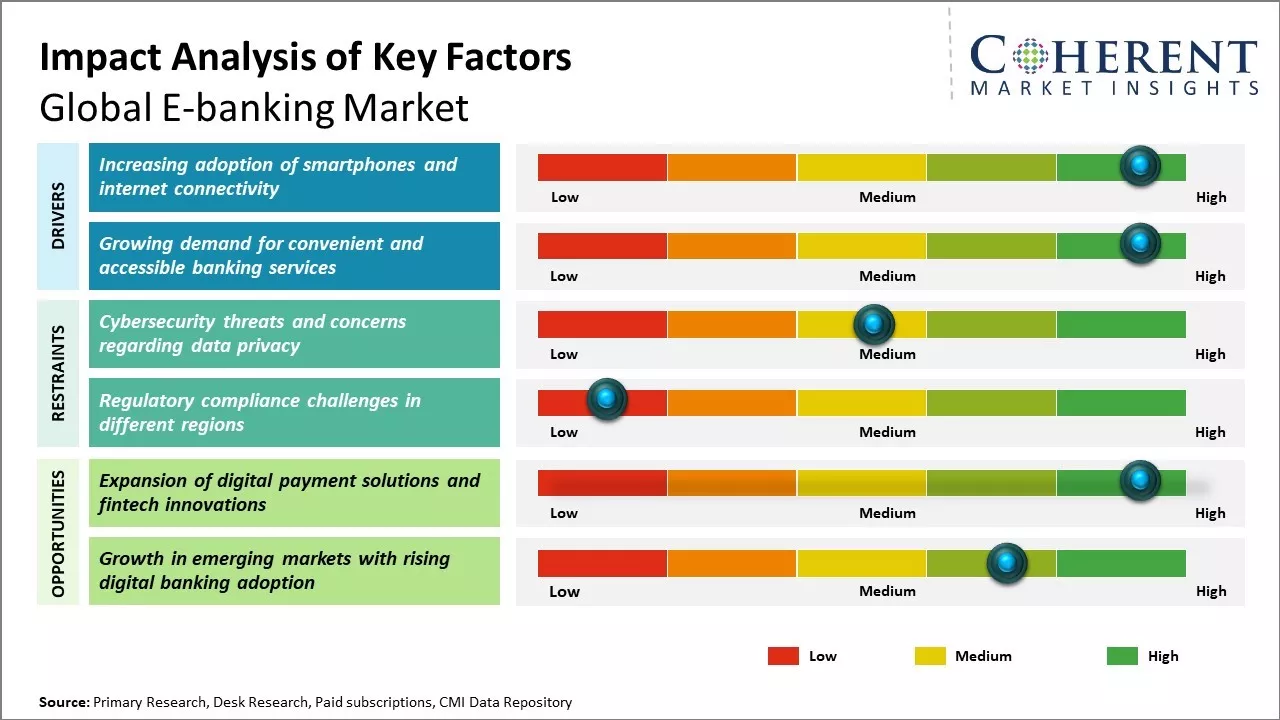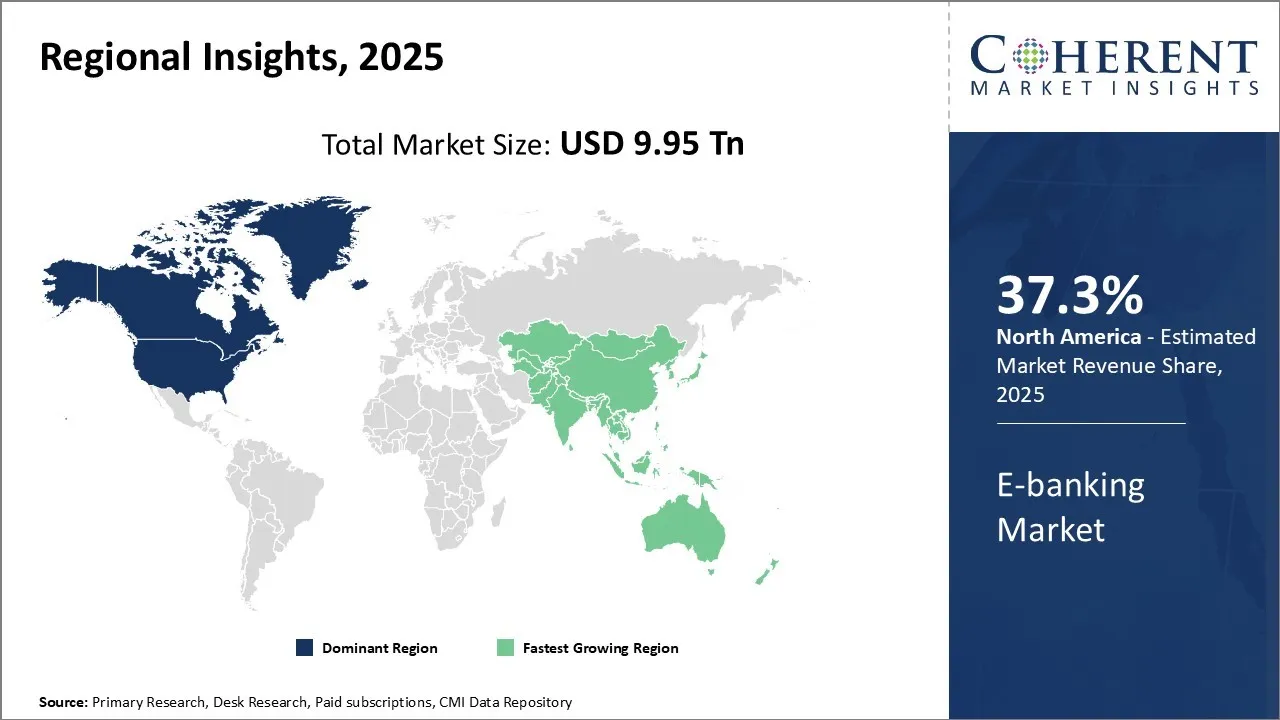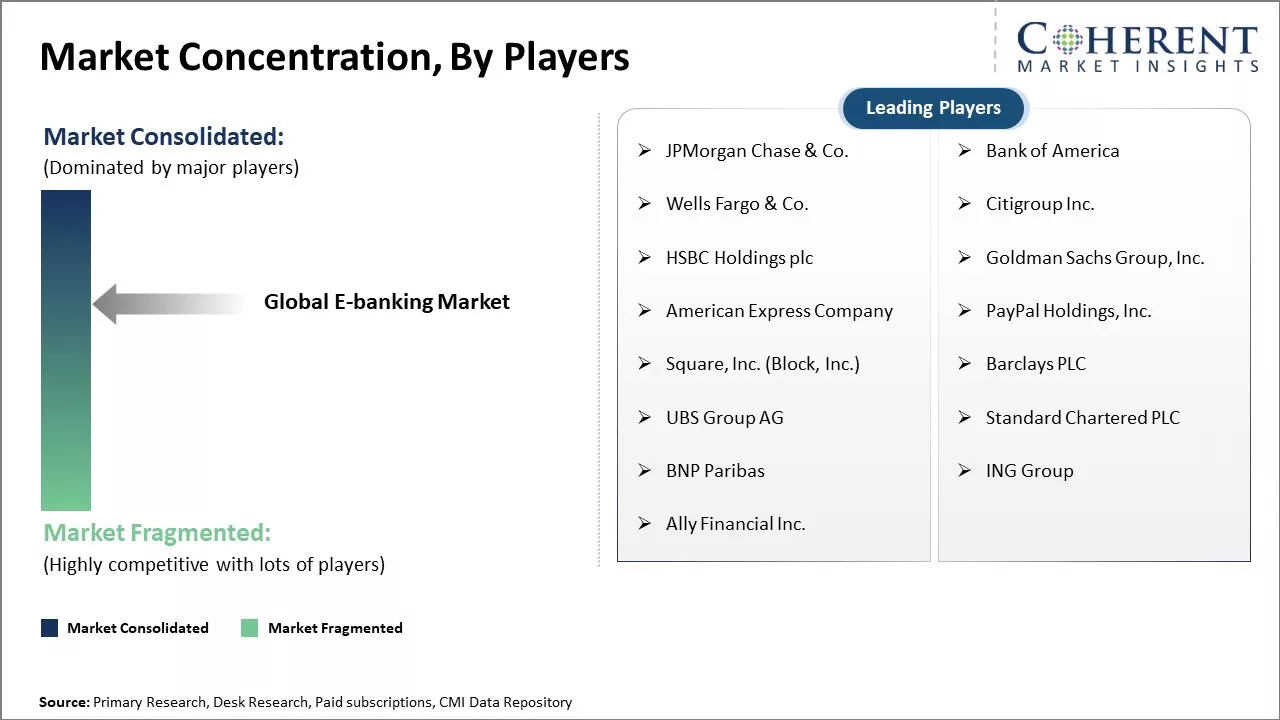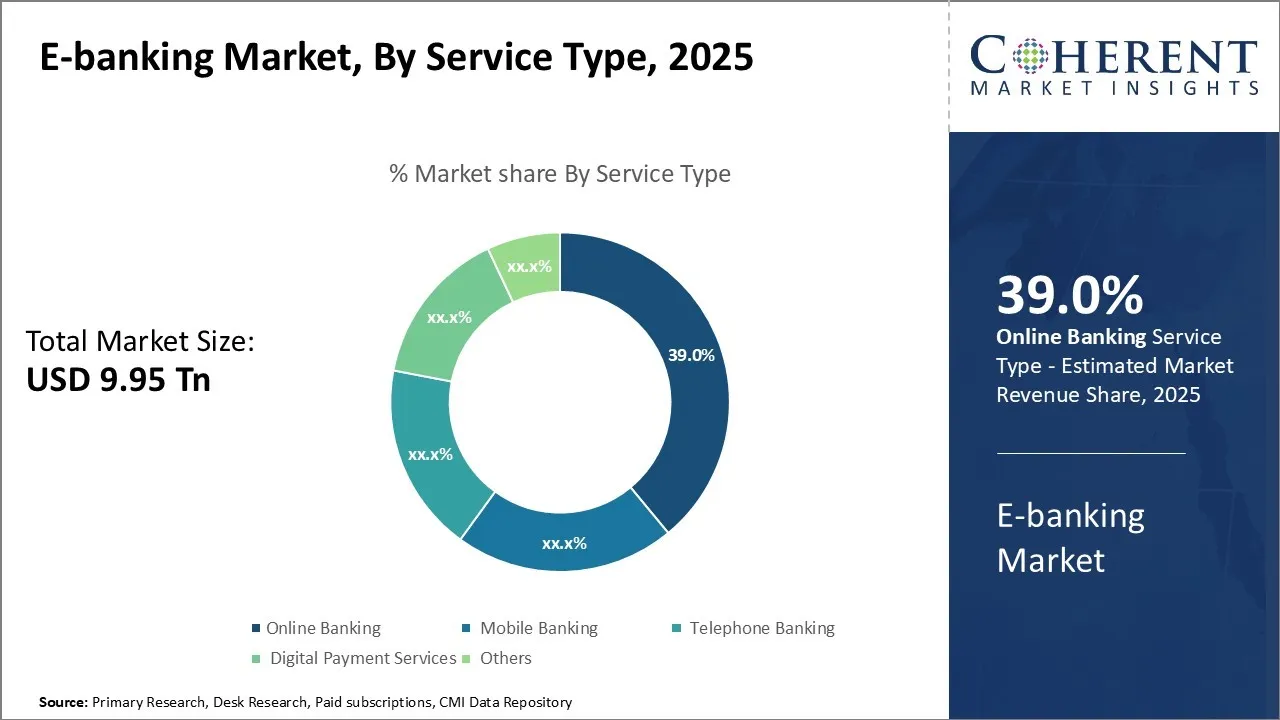E-banking Market Size and Forecast – 2025 to 2032
Global e-banking market is estimated to be valued at USD 9.95 Tn in 2025 and is expected to reach USD 14.20 Tn by 2032, exhibiting a compound annual growth rate (CAGR) of 5.2% from 2025 to 2032.

To learn more about this report, Download Free Sample
Key Takeaways
- Based on Service Type, Online Banking segment is projected to account for 39.0% shares of the global market in 2025, owing to its unmatched convenience.
- Based on Application, the Payment segment is expected to capture the 40.6% share of the market in 2025, due to rise of convenient digital payment options.
- Based on End User, the individual segment is projected to command the 52.8% share of the market in 2025, due to its personalization features.
- Based on Region, North America is set to dominate the global market with a 37.3% share in 2025.
Market Overview
The growth can be attributed to the increasing adoption of digital payment among customers. Growing digitization and rising smartphone penetration across the world has made banking services more accessible online. Customers are increasingly preferring to pay bills, transfer funds and check account balances online from the ease and convenience offered by e-banking.
Furthermore, e-banking offers 24/7 availability of services which is appealing to modern customers. Banking institutions are also promoting e-banking solutions as it reduces operational costs and improves efficiency. With continued technology advancements, the e-banking market is expected to grow steadily in the coming years.
Current Events and Its Impact
|
Current Event |
Description and its Impact |
|
Central Bank Digital Currency (CBDC) Development and Implementation
|
|
|
Artificial Intelligence and Machine Learning Integration Race |
|
Uncover macros and micros vetted on 75+ parameters: Get instant access to report
Role of AI in the E-Banking Market
Artificial Intelligence (AI) is transforming the e-banking market by driving innovation, improving security, and enhancing customer experience.AI powers advanced data analytics, enabling banks to deliver personalized services by understanding customer behavior and preferences in real time. AI-driven chatbots and virtual assistants provide 24/7 customer support, improving responsiveness and reducing operational costs.
For instance, Backbase announces a major industry shift: the launch of the world’s first AI-powered Banking Platform, following the launch of its Intelligence Fabric in September 2024.
Market Drivers - Increasing adoption of smartphones and internet connectivity
The rising affordability and usefulness of smartphones has resulted in their remarkably high adoption globally in recent years. Smartphone users worldwide now total 7.21 billion—around 90% of the global population—though ownership and usage vary greatly between the global and U.S. markets. Additionally, access to reliable and fast internet has expanded tremendously both in developed as well as developing nations. This ongoing digital transformation has not only changed the way people communicate and consume information & entertainment but has also revolutionized how banking services are accessed.
Growing demand for convenient and accessible banking services
Consumers have increasingly less tolerance for long queues and waiting periods, cumbersome documentation procedures, and limited banking hours which were once synonymous with traditional branch visits. Their expectations of immediacy, simplicity and availability have risen tremendously in the fast-paced digital age.
Meanwhile, the hectic schedules and busy lifestyles of modern urban populations leave little time or opportunity for running errands to the bank. This has created considerable demand for banking services that can be accessed with minimal effort and disruption any time of the day from anywhere.
Meeting such dynamic preferences and evolving with customer needs is of paramount importance for banks to not lose their clientele to more innovative competitors. Those adopting digital transformation and an 'always-on' approach through robust online and mobile offerings have been able to strengthen their customer relationships and satisfaction levels.
People feel respected and well-served when financial institutions make their lives more hassle-free through technology instead of unnecessary physical hoops. Thoroughly digital banks with no physical branches whatsoever pose a strong promise of never turning customers away and providing the ultimate convenience through websites and apps accessible on any device round-the-clock.
Market Opportunity - Expansion of Digital Payment Solutions
One major opportunity for the global e-banking market is the expansion of digital payment solutions and fintech innovations. The rise of mobile-first services and tech-savvy younger demographics is accelerating demand for fast, seamless digital transactions. Technologies like mobile wallets, P2P money transfer applications, digital assets and contactless payments allow customers to manage finances on the go in just a few taps.
Banks expanding their own payment platforms can gain a competitive edge, while strategic partnerships with fintech startups open up new revenue streams. Both digital payment providers and e-commerce merchants stand to benefit tremendously from the scaling up of innovative payment solutions. With cross-border payment solutions also evolving rapidly, opportunities exist for disruption across international remittances and B2B financial markets as well.
E-Banking Market Insights, by Service Type - Convenience Drives Growth in Online Banking
In terms of service type, online banking segment estimated to contribute the highest market share of 39.0% in 2025 owing to its unmatched convenience. Customers have come to expect being able to access basic banking services any time and from anywhere via their mobile devices or desktop.
Online banking allows people to pay bills, transfer funds between accounts, deposit checks, and more without having to visit a physical branch. This high level of accessibility has resonated strongly with consumers who lead busy lifestyles and value maximizing their time. The ability to bank remotely has also appealed to those who live in areas without easy access to traditional brick-and-mortar banks.
With online banking, basic transactions can be completed with just a few taps or clicks no matter where one is located. Additionally, many online-only banks offer perks like high interest savings accounts and lower or no fees that have attracted even general consumers. The seamless experience and time-saving benefits of online banking have cemented its place as the most utilized e-banking service.
For instance, in September 2025, Bank of India has unveiled a suite of next-generation banking solutions aimed at driving digital adoption, financial inclusion and customer-centric innovation.
E-Banking Market Insights, by Application - Digital Payments Drive Mobile Banking Usage
In terms of application, payments segment is estimated to contribute the highest market share of 40.6% in 2025 due to the rise of convenient digital payment options. Mobile banking allows people to pay bills, send money to friends and family, and make purchases both in physical stores and online all through their phones.
The ubiquity of smartphones combined with contactless payment technologies like tap-and-go cards and mobile wallets have truly accelerated mobile payments. Younger consumers in particular have readily adopted new payment technologies and come to expect being able to pay for things spontaneously through their devices.
Additionally, peer-to-peer payment apps like Venmo, Cash App, and PayPal have seen tremendous growth as people look for simple ways to split costs and pay each other back. Merchants also prefer digital payment methods like cards and mobile wallets over cash due to lower processing fees. The rapid rise of safe, fast, and seamless digital payment options has propelled mobile banking's payments application far above others.
For instance, in July 2025, Unified Payments Interface (UPI) has revolutionized financial transactions, with over 15 billion transactions processed monthly, totaling approximately ₹25 lakh crore. This surge is attributed to UPI's interoperability and ease of use, which have been pivotal in promoting financial inclusion and reducing reliance on cash
E-Banking Market Insights, by End User - Personalization attracts Individual customers
In terms of end user, individual customers are expected to hold 52.8% of the market share in 2025 due to personalization features attracting them. Individual customers are drawn to personalized online and mobile banking experiences tailored specifically to their financial situations and needs. Advanced technologies now allow banks to gather data on individual customers' transaction histories, locations, devices used for banking, and more to gain insights into their behaviors.
Banks then leverage these insights to provide targeted service improvements. For example, individual customers may receive customized savings or investment recommendations, spending alerts tailored to their patterns, or location-based offers for nearby merchants. Younger individual customers especially expect a high degree of personalization in the digital products and services they use.
As digital banking incorporates more Artificial Intelligence capabilities, banks will be able to deliver increasingly customized experiences down to a hyper-local level. This focus on individually understanding each customer and addressing their unique needs through personalization will continue attracting individual banking users ahead of other end user segments.
For instance, in June 2025, IndusInd Bank has announced the expansion of its flagship digital banking platform, ‘INDIE’, to over 15 million existing retail banking customers, aiming to redefine the digital banking experience with a hyper-personalised and secure approach.
Regional Insights

To learn more about this report, Download Free Sample
North America E-Banking Market Analysis & Trends
North America continues to dominate the global e-banking market with 37.3% of the market share in 2025, driven by high adoption rates among consumers. Leading financial institutions in the U.S. such as Bank of America, Citibank, and Wells Fargo have heavily promoted digital adoption through user-friendly interfaces and added convenience of services like bill payments from anywhere.
Another factor contributing to North America's lead is its developed payments infrastructure. Standards such as EMV chip technology and widespread contactless payments have accelerated the transition from physical to digital transactions. This has encouraged banks to invest more in upgrading online platforms and adding innovative features. For example, person-to-person payment services are increasingly popular in the U.S., fueling cashless trends.
For instance, in September 2025, VersaBank expanded its Receivable Purchase Program (RPP) by adding two new partners in Canada, including its first securitization partner.
Asia Pacific E-Banking Market Analysis & Trends
North America maintains a clear edge currently; the Asia Pacific region is emerging as the fastest growing market for e-banking globally. China especially has witnessed a surge in digital usage among its massive population. Major Banks in China such as ICBC and China Construction Bank have leveraged the country's rapid technological advancement and smartphone penetration to sign up hundreds of millions of online customers.
India too is reflecting strong momentum, with both prominent national banks and smaller fintech firms driving the digitalization of services. Across Asia, the large young demographics and growing affordability of internet access are powerhouses propelling future e-banking adoption rates upwards.
For instance, in December 2024, Deutsche Bank launched Merchant Solutions capabilities in Australia, India, Indonesia and South Korea. The solutions provide the bank’s clients with a global payment acceptance platform and access to a diverse range of local payment methods in these four markets.
E-Banking Market Outlook Country-Wise
U.S. E-Banking Market Trends
The U.S. e-banking market is rapidly evolving, driven by growing consumer adoption. Financial institutions are investing heavily in cybersecurity measures like multi-factor authentication and biometric verification to address increasing cyber threats, while leveraging AI and machine learning to enhance customer experience and fraud detection.
Meanwhile, major banks are closing physical branches to focus more on digital offerings, reflecting shifting consumer preferences. Looking ahead, the market is expected to expand further, with customers demanding more personalized, seamless, and integrated digital banking experiences.
For instance, in October 2024, Santander launched Openbank in the United States, enables the group to serve individual consumers nationwide for the first time, beyond its established branch network in the Northeast.
Japan E-Banking Market Trends
Japan's e-banking sector is undergoing a significant transformation, driven by a concerted push towards digitalization, regulatory advancements, and evolving consumer behaviors. Traditional financial institutions are investing heavily in digital infrastructure to compete with emerging digital banks.
For instance, in May 2025, Mitsubishi UFJ Financial Group Inc. (MUFG) unveiled a new bank specializing in online banking by the end of fiscal 2026 to attract new customers, particularly young people.
Market Concentration and Competitive Landscape

To learn more about this report, Download Free Sample
Key Takeaways from Analyst
Global e-banking market is experiencing strong growth driven by rising smartphone and internet penetration. Rising adoption of online and mobile banking services among consumers is a key driver as it allows banking on the go through apps and online portals. Growing preference for contactless and hassle-free banking is motivating many traditional banks to enhance their digital offerings. The market is also witnessing increasing collaborations of banks with FinTech companies to integrate newer technologies into existing digital platforms.
However, security and privacy concerns persist as a challenge. Customers remain wary of sharing financial details online due to growing incidents of cybercrime. Banks need to focus on addressing these concerns by tightening security features such as advanced authentication and monitoring. Regulatory frameworks also lag the pace of technological advancements, resulting in ambiguity at times.
Countries like U.S. and Japan are leading with high rates of digitalization and have emerged as some of the world's biggest fintech hubs. The younger demographics of these regions are more technology-savvy and driving digital adoption faster. North America and Asia Pacific are also major contributors but may see relatively slower growth due to maturity.
E-banking Industry News
- In April 2025, Regional rural bank (RRB) Karnataka Vikas Gramin Bank (KVGB) launched its new e-Bank Guarantee (e-BG) services in collaboration with the government’s information utility provider National E-Governance Services Limited (NESL) in Dharwad
- In November 2024, State-owned Punjab & Sind Bank announced the launch of e-Bank Guarantee (e-BG) facility in partnership with National e-Governance Services Ltd (NeSL) that replaces the paper-based BG issuance process with e-stamping and e-signatures.
Market Report Scope
E-banking Market Report Coverage
| Report Coverage | Details | ||
|---|---|---|---|
| Base Year: | 2024 | Market Size in 2025: | USD 9.95 Tn |
| Historical Data for: | 2020 To 2024 | Forecast Period: | 2025 To 2032 |
| Forecast Period 2025 to 2032 CAGR: | 5.2% | 2032 Value Projection: | USD 14.20 Tn |
| Geographies covered: |
|
||
| Segments covered: |
|
||
| Companies covered: |
JPMorgan Chase & Co., Bank of America, Wells Fargo & Co., Citigroup Inc., HSBC Holdings plc, Goldman Sachs Group, Inc., American Express Company, PayPal Holdings, Inc., Square, Inc. (Block, Inc.), Barclays PLC, UBS Group AG, Standard Chartered PLC, TNP Paribas, ING Group, and Ally Financial Inc. |
||
| Growth Drivers: |
|
||
| Restraints & Challenges: |
|
||
Uncover macros and micros vetted on 75+ parameters: Get instant access to report
Market Segmentation
- By Service Type Insights (Revenue, US$ Tn, 2020 - 2032)
- Online Banking
- Mobile Banking
- Telephone Banking
- Digital Payment Services
- Others
- By Application Insights (Revenue, US$ Tn, 2020 - 2032)
- Payments
- Processing Services
- Customer and Channel Management
- Risk Management
- Others
- By End User Insights (Revenue, US$ Tn, 2020 - 2032)
- Individual Customers
- Small and Medium Enterprises (SMEs)
- Large Enterprises
- Regional Insights (Revenue, US$ Tn, 2020 - 2032)
- North America
- U.S.
- Canada
- Latin America
- Brazil
- Argentina
- Mexico
- Rest of Latin America
- Europe
- Germany
- U.K.
- Spain
- France
- Italy
- Russia
- Rest of Europe
- Asia Pacific
- China
- India
- Japan
- Australia
- South Korea
- ASEAN
- Rest of Asia Pacific
- Middle East
- GCC Countries
- Israel
- Rest of Middle East
- Africa
- South Africa
- North Africa
- Central Africa
- Key Players Insights
- JPMorgan Chase & Co.
- Bank of America
- Wells Fargo & Co.
- Citigroup Inc.
- HSBC Holdings plc
- Goldman Sachs Group, Inc.
- American Express Company
- PayPal Holdings, Inc.
- Square, Inc. (Block, Inc.)
- Barclays PLC
- UBS Group AG
- Standard Chartered PLC
- TNP Paribas
- ING Group
- Ally Financial Inc.
Source
Primary Research Interviews
- Chief Technology Officers (CTOs) of leading banks and financial institutions
- Digital Banking Product Managers and Strategy Heads
- E-banking Solution Providers and Fintech Companies
- Regulatory Authorities and Compliance Officers
- Others
Databases
- Bloomberg Terminal Financial Database
- Thomson Reuters Eikon
- S&P Capital IQ Platform
- Statista Digital Market Outlook
- Others
Magazines
- Banking Technology Magazine
- Digital Banker
- Fintech Magazine
- American Banker
- Others
Journals
- Journal of Banking & Finance
- International Journal of Bank Marketing
- Electronic Commerce Research and Applications
- Others
Newspapers
- Financial Times
- The Wall Street Journal
- Reuters Financial News
- Banking Exchange
- Finextra News
- Others
Associations
- American Bankers Association (ABA)
- Electronic Transactions Association (ETA)
- International Association of Money Transfer Networks (IAMTN)
- Banking Administration Institute (BAI)
- Others
Public Domain Sources
- Federal Reserve Economic Data (FRED)
- Bank for International Settlements (BIS) Reports
- World Bank Financial Inclusion Database
- International Monetary Fund (IMF) Financial Access Survey
- Others
Proprietary Elements
- CMI Data Analytics Tool
- Proprietary CMI Existing Repository of information for last 8 years
*Definition: Global e-banking market provides online and mobile banking services to customers globally. It allows users to pay bills, transfer funds, deposit checks, manage accounts and investments, and get loans all via the internet or smartphone apps. Financial institutions use this digital platform to offer convenient banking anytime from anywhere to their international customer base. The e-banking solution aims to improve customer experience through personalized online banking portals accessible 24/7.
Share
Share
About Author
Ankur Rai is a Research Consultant with over 5 years of experience in handling consulting and syndicated reports across diverse sectors. He manages consulting and market research projects centered on go-to-market strategy, opportunity analysis, competitive landscape, and market size estimation and forecasting. He also advises clients on identifying and targeting absolute opportunities to penetrate untapped markets.
Missing comfort of reading report in your local language? Find your preferred language :
Transform your Strategy with Exclusive Trending Reports :
Frequently Asked Questions
EXISTING CLIENTELE
Joining thousands of companies around the world committed to making the Excellent Business Solutions.
View All Our Clients

